Lincoln Navigator: Driveshaft / Front Driveshaft. Removal and Installation
Special Tool(s) / General Equipment
| Crimping Tool |
Materials
| Name | Specification |
|---|---|
| Motorcraft® Premium Long-Life Grease XG-1-E1 |
ESA-M1C75-B |
Removal
-
With the vehicle in NEUTRAL, position the vehicle on a hoist.
Refer to: Jacking and Lifting (100-02 Jacking and Lifting, Description and Operation).
-
Remove the bolts and the transmission shield.
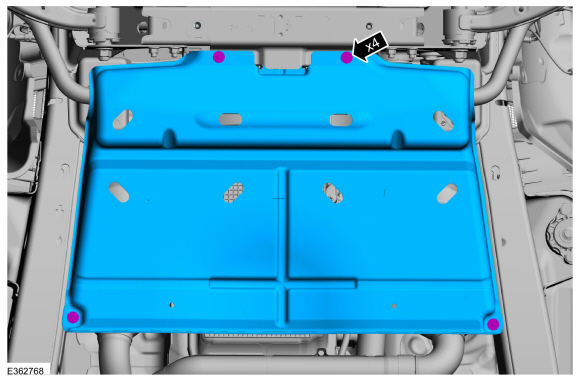 |
-
Index-mark the front driveshaft flange CV joint to the pinion flange cup.
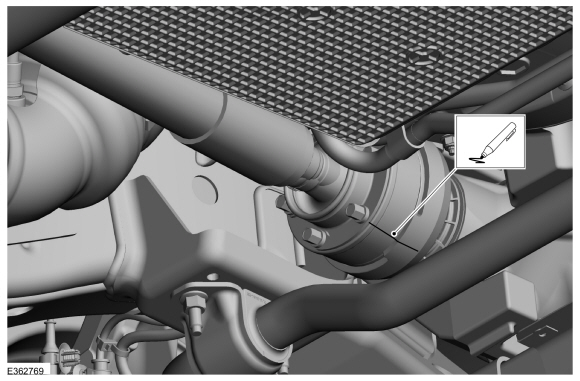 |
-
Remove and discard the stabilizer bar bracket nuts and allow the stabilizer bar to swing downward.
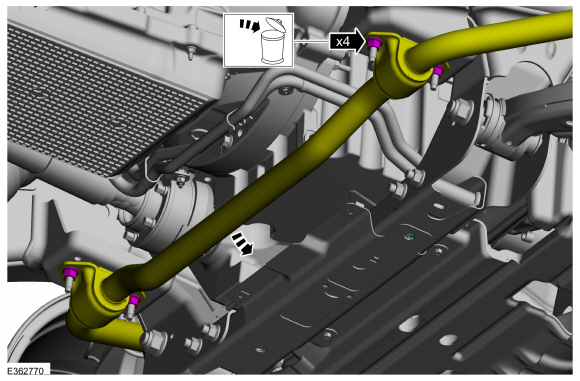 |
-
-
Remove and discard the front driveshaft CV joint-to-pinion flange cup bolts and retaining straps.
-
Support the front driveshaft.
-
Remove and discard the front driveshaft CV joint-to-pinion flange cup bolts and retaining straps.
 |
-
Remove the front driveshaft slip yoke boot clamp at transfer case end.
Use the General Equipment: Crimping Tool
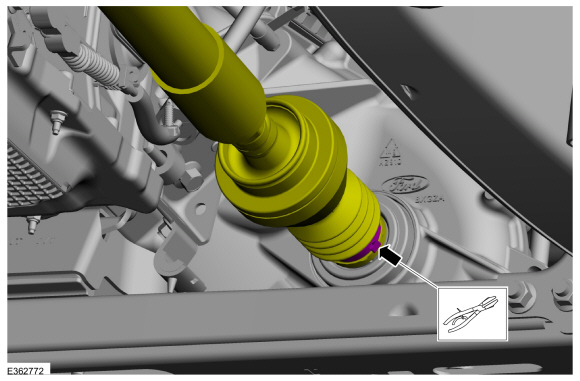 |
-
NOTE: Care should be taken not to damage the driveshaft splines.
-
Remove the front driveshaft from pinion flange and allow it to move rearward.
-
Pull and remove the front driveshaft from transfer case.
-
Remove the front driveshaft from pinion flange and allow it to move rearward.
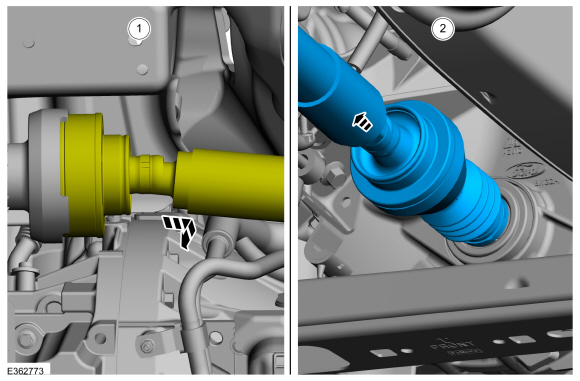 |
Installation
-
Clean and inspect the boot. If required replace the boot.
-
NOTE: Make sure that the mating faces are clean and free of foreign material.
Clean the debris or contamination of the splines.
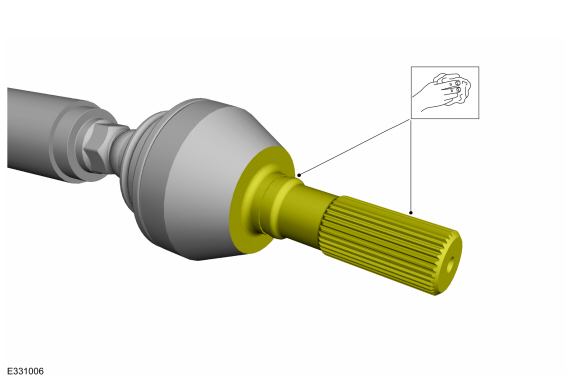 |
-
Lubricate the transfer case plug-on yoke splines with grease.
Material: Motorcraft® Premium Long-Life Grease / XG-1-E1 (ESA-M1C75-B)
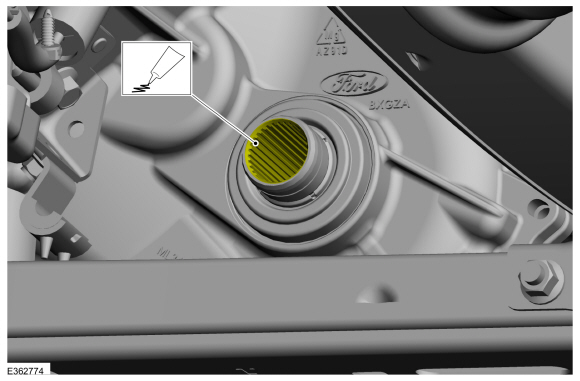 |
-
Insert the front driveshaft into the transfer case plug-on yoke and secure the boot clamp.
Use the General Equipment: Crimping Tool
 |
-
NOTE: Make sure that new components are installed.
-
Align the index-mark on the driveshaft and pinon flange.
-
Fit the driveshaft into the drive pinion flange.
-
Install the new front driveshaft CV joint-to-pinion flange cup retaining straps and bolts.
Torque: 41 lb.ft (55 Nm)
-
Align the index-mark on the driveshaft and pinon flange.
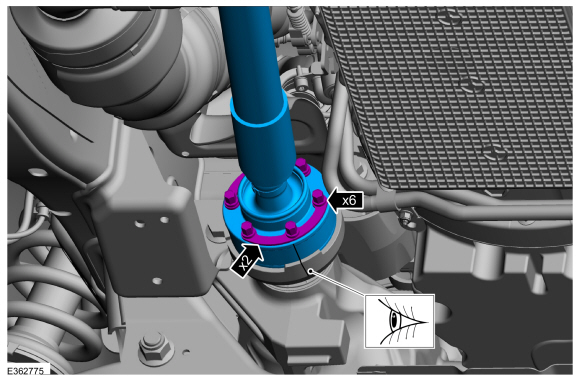 |
-
NOTE: Make sure that new nuts are installed.
Swing the stabilizer bar upward and install the new stabilizer bar bracket nuts.
Torque: 46 lb.ft (63 Nm)
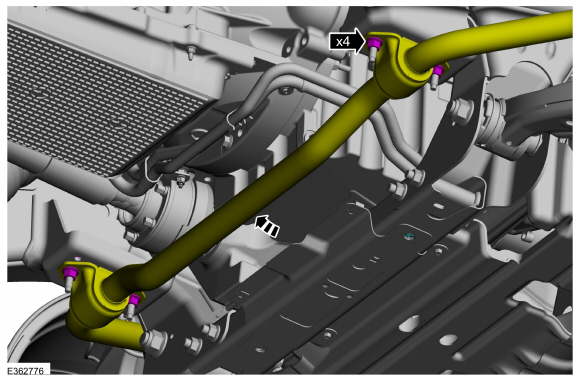 |
-
Install the transmission shield and the bolts.
Torque: 71 lb.in (8 Nm)
 |
 Driveshaft Runout and Balancing. General Procedures
Driveshaft Runout and Balancing. General Procedures
Special Tool(s) /
General Equipment
100-002
(TOOL-4201-C)
Holding Fixture with Dial Indicator Gauge
Inspection
NOTE:
Driveline vibration exhibits a higher frequency and lower
amplitude then high-speed shake...
 Rear Driveshaft. Removal and Installation
Rear Driveshaft. Removal and Installation
Special Tool(s) /
General Equipment
Flat Headed Screw Driver
Tire Lever
Removal
All vehicles
With the vehicle in NEUTRAL, position it on a hoist...
Other information:
Lincoln Navigator 2018-2025 Workshop Manual: Wipers and Washers - System Operation and Component Description. Description and Operation
System Operation System Diagram E363825 *.sttxt { visibility: hidden; } *.stcallout { visibility: visible; } 1 Wiper relay 2 BJB 3 Rain Sensor 4 Rear Wiper Motor 5 Winds..
Lincoln Navigator 2018-2025 Workshop Manual: Front Stabilizer Bar. Removal and Installation
Removal NOTICE: Suspension fasteners are critical parts that affect the performance of vital components and systems. Failure of these fasteners may result in major service expense. Use the same or equivalent parts if replacement is necessary. Do not use a replacement part of lesser quality or substitute design. Tighten fasteners as specified. NOTE: Removal steps in this proc..
Categories
- Manuals Home
- 4th Gen Lincoln Navigator Service Manual (2018 - 2025)
- Brake Service Mode Activation and Deactivation. General Procedures
- Rear View Mirrors - System Operation and Component Description. Description and Operation
- Telematics Control Unit (TCU) Module. Removal and Installation
- Body and Paint
- Front Bumper Cover. Removal and Installation
Wheel to Hub Runout Minimization. General Procedures
Check
NOTE: Wheel-to-hub optimization is important. Clearance between the wheel and hub can be used to offset or neutralize the Road Force® or run-out of the wheel and tire assembly. For every 0.001 inch of wheel-to-hub clearance, the Road Force® can be affected between 1 and 3 pounds depending on the tire stiffness.
NOTE: The example below illustrates how the clearance between the wheel and the hub can be used to offset the high spot of radial run-out or Road Force®. Following the procedure will make sure of the best optimization.
Position the wheel and tire assembly on the vehicle so that the high spot location of radial run-out or Road Force® is at the 6 o'clock position and